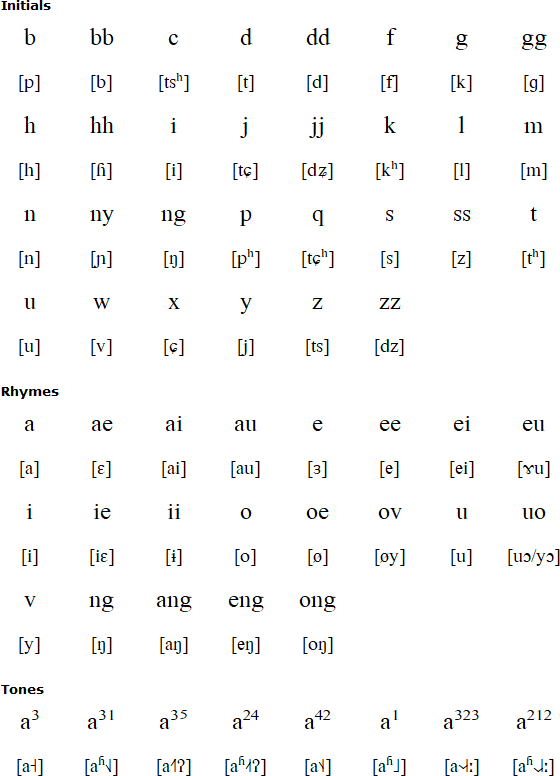Wenzhounese is a variety of Wu Chinese spoken in and around Wenzhou in Zhejiang Province in the south east of China. There are also some Wenzhou speakers in parts of Fujian Province, in Flushing and Brooklyn in New York, and in Italy France and Spain. Names for this language/variety include 温州话 (wēnzhōuhuà), Oujiang (瓯江话 - ōujiānghuà) and Dong'ou (東瓯)
Wenzhounese is the most divergent variety of Wu and is considered a separate language by some. It is not mutually intelligible with other varities of Wu. It preserves words from Classical Chinese that are no longer used in other varieties of Chinese, and its grammar differs significantly. It also has the most eccentic phonology, and as a result is considered the "least comprehensible dialect" for an average Mandarin speaker. These feature are a result of the geographic isolation of the Wenzhou area.
Wenzhounese is one of the varieties of Chinese used on China Radio International, along with Cantonese, Minnan, Teochew and Hakka.
Romanisation systems for writing Wenzhounese were developed by Christian missionaries during the 19th century. A Wenzhounese version of Matthew's gospel was published in 1892. A new system which represents all the sounds of Wenzhounese was developed by Shen Kecheng (沈克成) and Shen Jia (沈迦) in 2004.

There is a complex system of tone changes (Sandhi), and many letters are pronounced differently depending on which other letters they appear next to.
Download an alphabet chart for Wenzhounese (Excel)
Details of Wenzhounese pronunciation provided by Wolfram Siegel)
Information about Wenzhounese
http://en.wikipedia.org/wiki/Wenzhounese
http://en.wikipedia.org/wiki/Wenzhounese_romanisation

by Glossika
- Glossika's audiovisual method helps you master comprehension and achieve fluency. Great on its own, or the perfect companion to your ongoing studies.
Buy from: Glossika.com
Dungan, Cantonese, Fuzhounese, Gan, Hakka, Jian'ou, Mandarin, Puxian, Shanghainese, Taiwanese, Taiwanese Hakka, Teochew, Weitou, Wenzhounese, Xiang
Written Chinese: Oracle Bone Script, Simplified characters, Bopomofo, Types of characters, Structure of written Chinese, Evolution of characters, How the Chinese script works, Xiao'erjing, General Chinese
Spoken Chinese: Mandarin, Dungan, Wu, Shanghainese, Wenzhounese, Yue, Cantonese, Weitou, Min, Jian'ou, Taiwanese, Teochew, Fuzhounese, Puxian, Hakka, Xiang, Gan, How many people speak Chinese?
Other Chinese pages: Chinese numbers (數碼) | Chinese classifiers (量詞) | Electronic dictionaries | Chinese links | Books: Chinese characters and calligraphy | Cantonese | Mandarin, Shanghainese, Hokkien and Taiwanese
Akkadian Cuneiform, Ancient Egyptian (Demotic), Ancient Egyptian (Hieratic), Ancient Egyptian (Hieroglyphs), Chinese, Chữ-nôm, Cuneiform, Japanese, Jurchen, Khitan, Linear B, Luwian, Mayan, Naxi, Sawndip (Old Zhuang), Sui, Sumerian Cuneiform, Tangut (Hsihsia)
Page last modified: 15.03.23
[top]
You can support this site by Buying Me A Coffee, and if you like what you see on this page, you can use the buttons below to share it with people you know.

If you like this site and find it useful, you can support it by making a donation via PayPal or Patreon, or by contributing in other ways. Omniglot is how I make my living.
Note: all links on this site to Amazon.com, Amazon.co.uk
and Amazon.fr
are affiliate links. This means I earn a commission if you click on any of them and buy something. So by clicking on these links you can help to support this site.
[top]